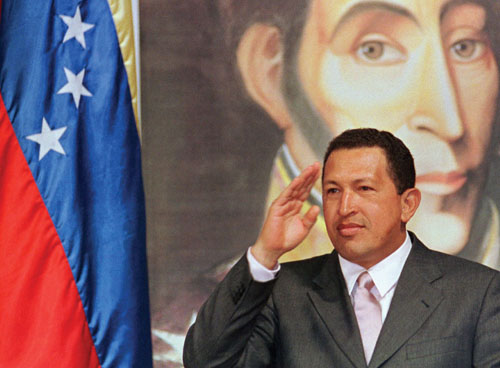
Venezuela President Hugo Chávez pictured with a painting
of Simón Bolivar in the background.
Photo: AP
March 28, 2010
In 2007 and 2008, my wife and I traveled to the Bolivarian Republic of Venezuela — where Simón Bolivar is revered as a national hero, the country’s liberator from Spain. We were, therefore, cautioned never to show disrespect for Bolivar. Hugo Rafael Chávez Frias, the current president of Venezuela, frequently links himself to this legendary figure to gain popular support for his programs both at home and abroad. But who exactly is Simón Bolivar?
Simón Bolivar was born in Caracas, Venezuela in 1783. At age 16, he was sent abroad to continue his education in Spain and France where he was introduced to the progressive works of Rousseau and Voltaire. He married Spaniard Maria Teresa and returned to Venezuela. Unfortunately, Maria Teresa died 8 months later of yellow fever. He never married again but had many lovers, including Manuela Saenz affectionately known as Manuleta, whom he met in 1822 and who was with him until a few days before he died. After Maria Teresa’s death, he returned to France and met with the leaders of the French Revolution. Bolivar then traveled to the United States to witness the U.S. after the American Revolution. He returned to Caracas filled with revolutionary ideas and quickly joined pro-independence groups. Bolivar’s military career began under Francisco de Miranda. When Miranda was captured by the Spanish in 1812, Bolivar took command.
Over the next decade, Bolivar commanded the independence forces in numerous battles, including the key battle of Carabobo, which brought independence for Venezuela. Bolivar also brought independence from Spanish rule to the entire northwest of South America, creating the Gran Colombia in what today comprises Venezuela, Colombia, Panama, Ecuador, Peru, and Bolivia. Because his central government could not govern such a large land mass with its racial and regional differences, his Gran Colombia lasted just a decade. Disillusioned and in bad health, Bolivar resigned the presidency of Gran Colombia in early 1830. He died in December 1830 at age 47, in Santa Marta, Colombia, while on his way to Europe. Ironically, the newly independent Venezuela banned Bolivar from his homeland for twelve years until 1842, when his remains were finally brought from Santa Marta to Caracas and entombed in the “catedral.” In 1876, his remains were transferred to the “Panteon Nacional.”
During our brief stays in Caracas, Venezuela’s capital city, we did a mini-tour of Bolivariana, which began at the Plaza Bolivar. By the way, every Venezuelan city has a Plaza Bolivar. The federal district (Caracas) and the capital cities of Venezuela’s twenty-two states such as Merida, Coro, Barinas, Guanare, capital cities we visited, have a statue of Bolivar on a horse. Other major cities have a statue of Bolivar unhorsed, and smaller towns have a bust of Bolivar in their Plaza Bolivar.
We visited Bolivar’s birthplace (“Casa Natal de Bolivar”), the Bolivar museum next door where I was asked to remove my cap out of respect (“Museo Bolivariana”), the nearby cathedral where he was baptized and where his wife and family lie, and the “Panteon Nacional” containing his body and those of other eminent Venezuelans.
Last year, we took a road trip along the coast from Cartagena, Colombia to visit Quinta de San Pedro Alejandrino, the hacienda where Bolivar spent his last days before he died. Spaniard Joaquin de Mier, the owner of the hacienda, a supporter of Colombia’s independence, invited Bolivar to stay and rest until his departure for Europe. The hacienda grounds contain massive central structure (“Altar de la Patria”), the Museo Bolivariana, and a 22-hectare garden.
Hugo Chavez envisions a modern day “Bolivarian Revolution,” a Latin American political block with a socialist bent as an alternative to United States hegemony. Chavez has been generous with his foreign aids to Latin America and the Caribbean in an effort to blunt U.S.-backed economic policies in Latin America. His efforts have garnered some support among the growing number of Latin America’s left-leaning governments.
Only time will tell whether Chavez’s “Bolivarian Revolution” will succeed. In the meantime, many Venezuelans want Chavez to tend to problems on the home front such as government corruption, inefficiency, and mismanagement; the deteriorating health and education programs; the troubled economy; crime, human rights violations, and media censorship. I join the Venezuelans in their fear that the socialist revolutionary has morphed into a dictator for life.
Did you know that there is a statue of Simón Bolivar on a horse in San Francisco’s United Nations Plaza? It is a 1984 “Gift from Venezuela to the People of San Francisco.”
This article is a revised and updated version of an article originally published in BeyondChron on March 25, 2008.


 The Hunger Site
The Hunger Site
No Comments
Comments for Discovering Simón Bolivar are now closed.